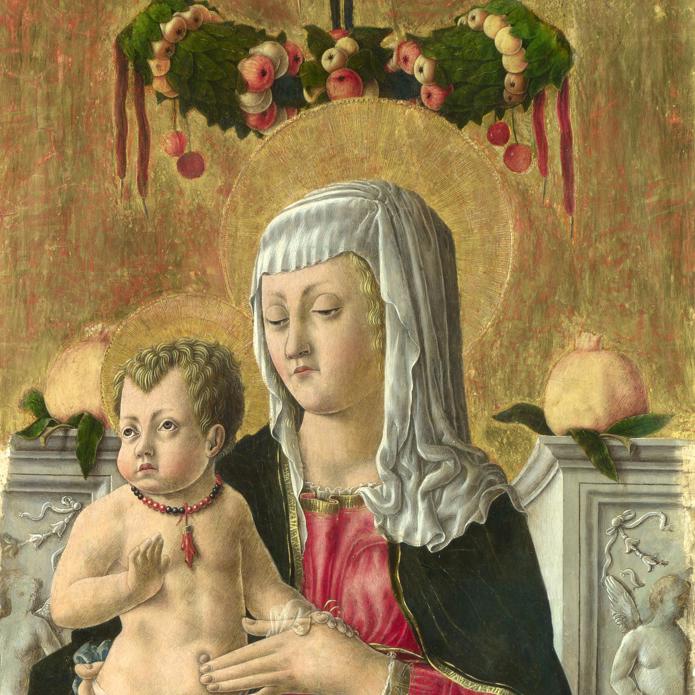Giorgio Schiavone, 'Saint Anthony of Padua', probably 1456-61
About the work
Overview
A friar stands on a marble plinth, holding a lily and a book. This is a thirteenth-century saint, Antony of Padua. He wears the grey habit of the Observants, a strict, reformed branch of the Franciscans, an order of friars founded by Saint Francis of Assisi.
The book symbolises Saint Anthony’s learning – he was renowned both as a preacher and a university lecturer – and the lily his chastity. His bare toes peep out from under his robe – Franciscans wore sandals in both summer and winter – and one juts out over the edge of the plinth, linking the sacred space of the altarpiece with the real space of the viewer.
He once stood at the left side of a large polyptych (multi-panelled altarpiece) painted by Giorgio Schiavone, possibly for the church of San Niccolò in Padua. Other parts of the altarpiece are also in the National Gallery’s collection.
Key facts
Details
- Full title
- Saint Anthony of Padua
- Artist
- Giorgio Schiavone
- Artist dates
- 1436/7 - 1504
- Part of the series
- S. Niccolò Altarpiece, Padua
- Date made
- probably 1456-61
- Medium and support
- egg tempera on wood
- Dimensions
- 66 × 23 cm
- Acquisition credit
- Bought, 1860
- Inventory number
- NG630.3
- Location
- Not on display
- Collection
- Main Collection
Provenance
Additional information
Text extracted from the ‘Provenance’ section of the catalogue entry in Martin Davies, ‘National Gallery Catalogues: The Earlier Italian Schools’, London 1986 and supplemented by Anna McGee; for further information, see the full catalogue entry.
Bibliography
-
1951Davies, Martin, National Gallery Catalogues: The Earlier Italian Schools, London 1951
-
1986Davies, Martin, National Gallery Catalogues: The Earlier Italian Schools, revised edn, London 1986
-
2001
C. Baker and T. Henry, The National Gallery: Complete Illustrated Catalogue, London 2001
About this record
If you know more about this painting or have spotted an error, please contact us. Please note that exhibition histories are listed from 2009 onwards. Bibliographies may not be complete; more comprehensive information is available in the National Gallery Library.
Images
About the series: S. Niccolò Altarpiece, Padua

Overview
This two-tier altarpiece was painted between about 1456 and 1461 for the funerary chapel of the wealthy Roberti family in the church of San Nicolò in Padua. Its altar was dedicated to the Franciscan missionary Bernardino of Siena, seen among the full-length saints in the lower tier. He was canonised in 1450, shortly before Giovanni de Roberti left funds in his will for the chapel’s construction.
Other saints were chosen for their special significance for members of the Roberti family. John the Baptist was the name saint of Giovanni de Roberti. His sons Antonio and Piero were represented by Anthony of Padua and Peter Martyr, who were also the patron saints of Padua. The altarpiece must have had an elaborate original frame, which has been lost.
The illusory label attached to the base of the Virgin’s throne in the centre panel identifies the altarpiece as the work of Giorgio Schiavone, a disciple of Francesco Squarcione. ‘Schiavone’ means ‘the Slavonian’, referring to the fact that the artist came from Dalmatia (in modern-day Croatia).











